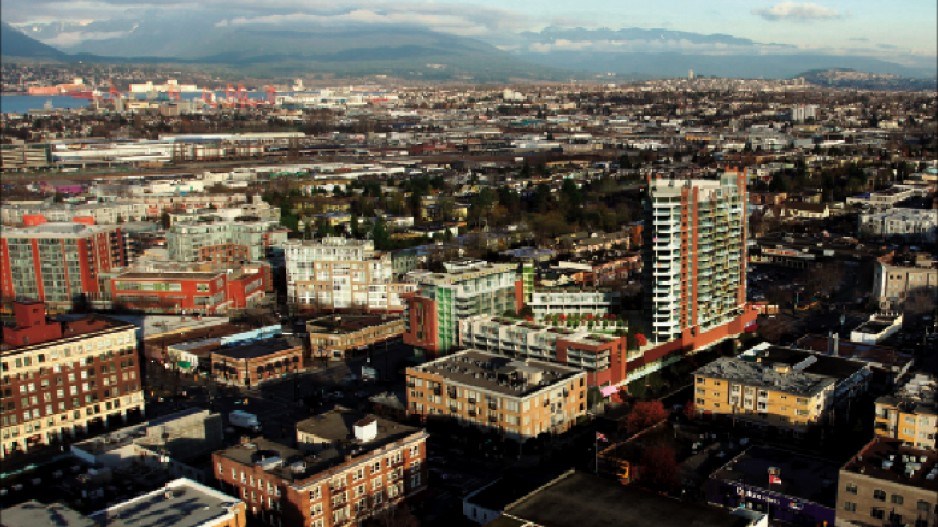Vigorous protests over major Vancouver development proposals such as Paragon Gaming Corp.’s mega-casino attached to BC Place are proof that the city’s way of soliciting community input is broken, say critics.
Architects, designers and real estate consultants believe more consultation is needed earlier in the process to provide clarity and reduce the chance that the public will be surprised with projects that some call “spaceships” that land without warning.
“It’s not developers that are the enemy. The enemy is the flawed process that the city uses for rezoning large development sites,” architectural designer Annabel Vaughan told city council last month at a public hearing into Rize Alliance Properties Ltd.’s plan to build a 19-storey tower at the corner of East Broadway and Kingsway Avenue.
“The current public process brings out the worst in everyone: developers and architects design projects in isolation and then land spaceships into neighbourhoods,” said Vaughan, who is a principal at publicLAB RESEARCH + DESIGN and a sessional instructor at the BC Institute of Technology (BCIT).
The city consulted residents in the leadup to November 2010, when council passed the Mount Pleasant Community Plan (MPCP) and designated three sites in Mount Pleasant as sites ideal for towers:
•the IGA property on Main Street and East 14th Avenue;
•Kingsgate Mall; and
•the Rize Alliance site across Kingsway Avenue from Kingsgate Mall.
The problem, say members of the Residents Association of Mount Pleasant (RAMP), which opposes Rize’s plan to build a 19-storey tower on the site is that the city never specified in the community plan how tall a tower would be built on the Rize site.
Rize originally designed a 26-storey tower, but it has since reduced the height, though not enough for RAMP activists, who prefer the size of the 10-storey structures built on West Broadway.
Developer Will Lin shrugs off many of the protesters as simply “coming to the table too late.”
He’s confident that he has followed the MPCP, which both council and the community endorsed, and he believes protests are a natural part of living in a democracy.
“[RAMP] is entitled to voice their opinion,” Lin told Business in Vancouver.
“The staff report clearly stated that there were 4,000 feedbacks to the city about our project and over half are in favour. It is clearly the case that the people against the project are louder and more passionate.”
PCI Group faced community protests two years ago when it revealed designs for its Marine Gateway project that resembled stacked containers.
PCI altered its designs to a more standard podium and towers.
They proved so popular that 11,000 people expressed interest with marketer Rennie Marketing Systems before the homes went on sale March 17, and the towers’ 415 units sold in four hours.
No one at PCI was available to discuss the cost in changing the designs.
Brook Pooni Associates Inc. principal Gary Pooni told BIV that the biggest weakness in the city’s consultation process is that too often it relies on traditional public hearings and doesn’t effectively use technology.
“The public hearing process has been around for over 100 years, and it came from people lining up at city hall, with or without their pitchforks,” he said. “They’ve got to find a better way to engage the next generation.”
Pooni advocates that city planners:
•gather feedback on projects through social media;
•approach professors at Langara College’s Applied Urban and Rural Planning department and University of British Columbia’s School of Architecture and Landscape Architecture to send students e-bulletins about public consultation; and
•do more outreach to bloggers.
Michael Green Architecture principal Michael Green plans to launch a website next month to seek public input for how to challenge conventions in Vancouver architecture.
He is also moderating an April 12 discussion with innovative Danish architect Bjarke Ingels on that topic at the Chan Centre.
Ingels has a cult following in global architectural circles and has designed a twisty, 49-storey tower, modelled after New York City’s Flatiron Building, for Westbank Projects Corp. next to the Granville Bridge at Beach Avenue and Howe Street.
“We don’t have a name for the website yet,” Green said, “but it will be about how to transform Vancouver with ideas that don’t necessarily conform.” •




